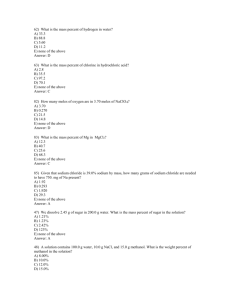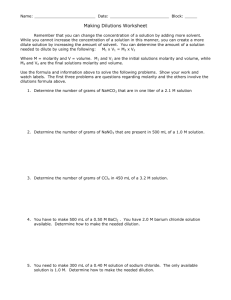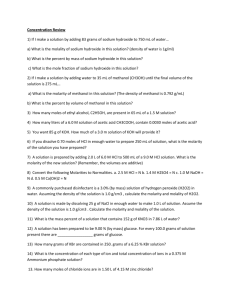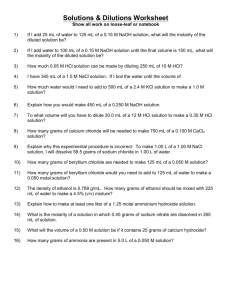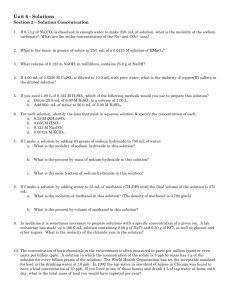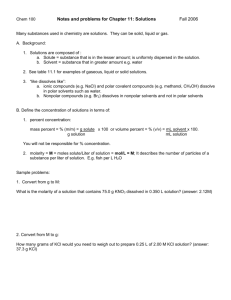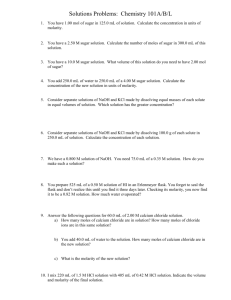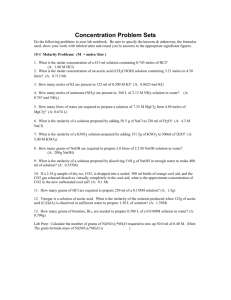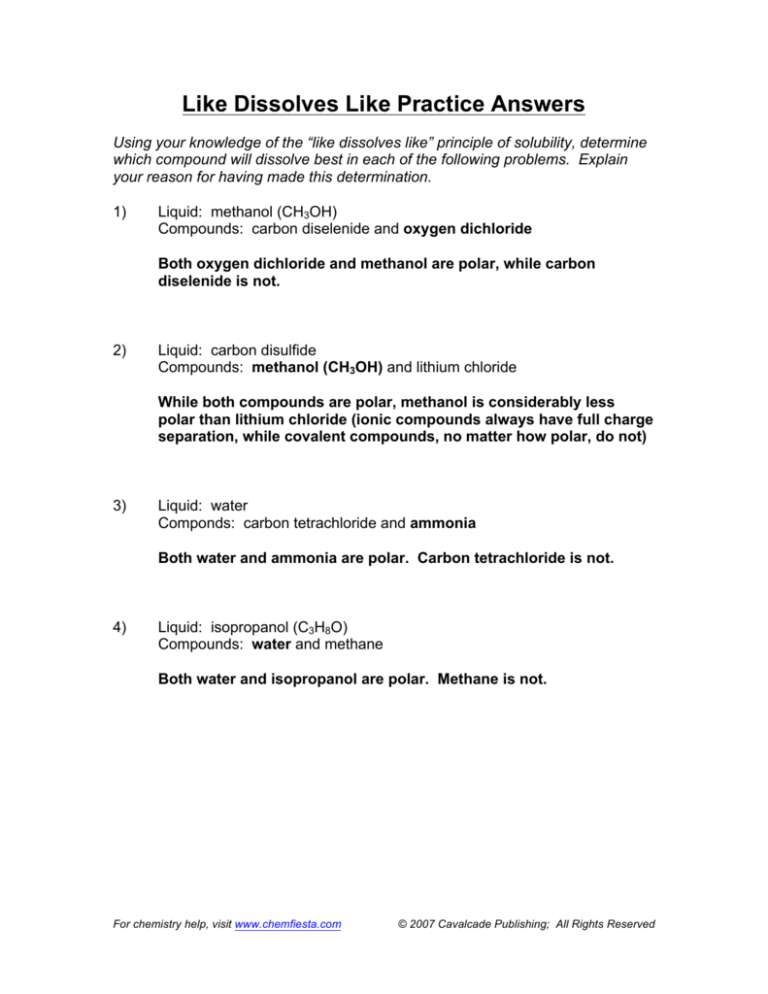
Like Dissolves Like Practice Answers
Using your knowledge of the “like dissolves like” principle of solubility, determine
which compound will dissolve best in each of the following problems. Explain
your reason for having made this determination.
1)
Liquid: methanol (CH3OH)
Compounds: carbon diselenide and oxygen dichloride
Both oxygen dichloride and methanol are polar, while carbon
diselenide is not.
2)
Liquid: carbon disulfide
Compounds: methanol (CH3OH) and lithium chloride
While both compounds are polar, methanol is considerably less
polar than lithium chloride (ionic compounds always have full charge
separation, while covalent compounds, no matter how polar, do not)
3)
Liquid: water
Componds: carbon tetrachloride and ammonia
Both water and ammonia are polar. Carbon tetrachloride is not.
4)
Liquid: isopropanol (C3H8O)
Compounds: water and methane
Both water and isopropanol are polar. Methane is not.
For chemistry help, visit www.chemfiesta.com
© 2007 Cavalcade Publishing; All Rights Reserved
Concentration Worksheet – Answers
1)
How many grams of beryllium chloride are needed to make 125 mL of a
0.050 M solution?
0.50 grams
2)
How many grams of beryllium chloride would you need to add to 125 mL
of water to make a 0.050 molal solution?
0.50 grams
3)
The density of ethanol is 0.789 g/mL. How many grams of ethanol should
be mixed with 225 mL of water to make a 4.5% (v/v) mixture?
7.99 grams
4)
Explain how to make at least one liter of a 1.25 molal ammonium
hydroxide solution.
Dissolve 43.8 grams (1.25 moles) of ammonium hydroxide in 1 L H2O.
5)
What is the molarity of a solution in which 0.45 grams of sodium nitrate
are dissolved in 265 mL of solution.
0.020 M
6)
What is the mole fraction of sulfuric acid in a solution made by adding 3.4
grams of sulfuric acid to 3,500 mL of water?
1.8 x 10-4
7)
What will the volume of a 0.50 M solution be if it contains 25 grams of
calcium hydroxide?
680 mL
8)
How many grams of ammonia are present in 5.0 L of a 0.050 M solution?
4.3 grams
For chemistry help, visit www.chemfiesta.com
© 2007 Cavalcade Publishing; All Rights Reserved
Concentration Worksheet – Answers
1)
Explain why chemical compounds tend to dissolve more quickly in hot
solvent than in cold solvent.
The solvent molecules have more energy to pull the solute particles
apart.
2)
Give an example of two liquids that are immiscible.
Oil and water.
3)
The pressure at the bottom of a lake is 2.35 atm. If water saturated with
oxygen (concentration 0.34 g/L) is carried by a current to to a depth where
the solubility of oxygen is 0.21 g/L, what is the pressure of the water.
1.45 atm
4)
How can you make a saturated solution from a supersaturated solution?
Add a seed crystal – the solute will crystallize out until you get a
saturated solution.
5)
How can you make a supersaturated solution from a saturated solution?
If it’s a hot saturated solution, you can cool it. If it’s not, you can let
the solvent evaporate to make it more concentrated.
6)
How can you make an unsaturated solution from a saturated solution?
Add solvent.
7)
What is the molarity of a solution made when you dilute 35 grams of
sodium carbonate to a volume of 3,400 mL?
0.097 M
8)
Explain how you would make 450 mL of a 0.25 M calcium chloride
solution.
Add water to 12.5 grams of calcium chloride until the solution has a
final volume of 450 mL.
For chemistry help, visit www.chemfiesta.com
© 2007 Cavalcade Publishing; All Rights Reserved
Concentration Review Worksheet Answers
1)
If I make a solution by adding 83 grams of sodium hydroxide to 750 mL of
water…
To solve problem 1, you need to have calculated for various parts that there
are 2.08 moles of NaOH (which has a molar mass of 40 g/mol), that there are
750 grams of water (which has a density of 1 g/mL), and that there are 41.67
moles of water (which has a molar mass of 18 g/mol).
2)
a)
What is the molality of sodium hydroxide in this solution?
2.77 m (2.08 mol / 0.75 kg water)
b)
What is the percent by mass of sodium hydroxide in this solution?
9.96% (found by finding 83 g / 833 g and multiplying by 100%)
c)
What is the mole fraction of sodium hydroxide in this solution?
0.0475 (found by finding 2.08 mol / 43.75 mol)
If I make a solution by adding water to 35 mL of methanol (CH3OH) until the
final volume of the solution is 275 mL…
When solving this problem, you’ll need to calculate that there are 27.72
grams of methanol (from the density), which is equal to 0.866 mol.
a)
What is the molarity of methanol in this solution? (The density of
methanol is 0.792 g/mL)
3.15 M (0.866 mol/0.275 L)
b)
What is the percent by volume of methanol in this solution?
12.7% ( (35 mL/275 mL) X 100)
For chemistry help, visit www.chemfiesta.com
© 2007 Cavalcade Publishing; All Rights Reserved
Dilutions Worksheet - Solutions
1)
If I add 25 mL of water to 125 mL of a 0.15 M NaOH solution, what will the
molarity of the diluted solution be?
M1V1 = M2V2
(0.15 M)(125 mL) = x (150 mL)
x = 0.125 M
2)
If I add water to 100 mL of a 0.15 M NaOH solution until the final volume is 150
mL, what will the molarity of the diluted solution be?
M1V1 = M2V2
(0.15 M)(100 mL) = x (150 mL)
x = 0.100 M
3)
How much 0.05 M HCl solution can be made by diluting 250 mL of 10 M HCl?
M1V1 = M2V2
(10 M)(250 mL) = (0.05 M) x
x = 50,000 mL
4)
I have 345 mL of a 1.5 M NaCl solution. If I boil the water until the volume of
the solution is 250 mL, what will the molarity of the solution be?
M1V1 = M2V2
(1.5 M)(345 mL) = x (250 mL)
x = 2.07 M
5)
How much water would I need to add to 500 mL of a 2.4 M KCl solution to make
a 1.0 M solution?
M1V1 = M2V2
(2.4 M)(500 mL) = (1.0 M) x
x = 1200 mL
1200 mL will be the final volume of the solution. However, since there’s
already 500 mL of solution present, you only need to add 700 mL of water to
get 1200 mL as your final volume. The answer: 700 mL.
For chemistry help, visit www.chemfiesta.com
© 2007 Cavalcade Publishing; All Rights Reserved
Solutions to the Molarity Practice Worksheet
For the first five problems, you need to use the equation that says that the
molarity of a solution is equal to the number of moles of solute divided by the
number of liters of solution.
1)
In this problem, simply solve using the molarity equation to find that the
concentration of the solution is 10 M.
2)
To use the molarity equation, you need to convert grams of sodium
chloride to moles of sodium chloride before you can use the molarity
equation. Because you have 0.0085 moles of NaCl in this solution, the
total concentration is 0.17 M.
3)
To use the molarity equation, you need to convert grams of NaCl to moles
and mL of solution to liters. When you do this, the total concentration of
the solution is 170.9 M. As it turns out, this isn’t a realistic value for
molarity, so you’d never see a solution with this concentration out in the
real world. Why did I give it to you then? I did it because I wanted you to
see that just by changing a few units, you can get very different final
answers.
4)
This is done in the same method that you’d solve #3. Because you have
6.68 moles of Li2SO4 and 2.500 liters of water, the overall molarity of your
solution is 2.67 M.
5)
This problem is also solved in the same way as #3 and #4. Because you
have 1.51 x 10-4 moles of Pb(C2H3O2)4, and 0.0035 L of water, the total
concentration is 4.32 x 10-2 M, or 0.0432 M.
6)
The equation for molarity states that the molarity of a solution is equal to
the number of moles of solute divided by the number of liters of solution.
In the first equation, the molarity will clearly be equal to 1.0 M, because
there are 1.0 moles of NaCl and a solution volume of 1.0 L. In the second
solution, the molarity will be different, because the solution volume will be
greater than 1.0 liters. Why? If you already have 1.0 L of water and add
1.0 moles of salt to it, it will overflow, right? This is because the volume
will be (roughly) equal to the volume of the water plus the volume of the
salt, which will be greater than 1.0 L. It is for this reason that when you
make a solution, you always dissolve the solute in only a little bit of water
and then add water to make your final volume.
For chemistry help, visit www.chemfiesta.com
© 2007 Cavalcade Publishing; All Rights Reserved
Like Dissolves Like Practice Answers
Using your knowledge of the “like dissolves like” principle of solubility, determine
which compound will dissolve best in each of the following problems. Explain
your reason for having made this determination.
1)
Liquid: methanol (CH3OH)
Compounds: carbon diselenide and oxygen dichloride
Both oxygen dichloride and methanol are polar, while carbon
diselenide is not.
2)
Liquid: carbon disulfide
Compounds: methanol (CH3OH) and lithium chloride
While both compounds are polar, methanol is considerably less
polar than lithium chloride (ionic compounds always have full charge
separation, while covalent compounds, no matter how polar, do not)
3)
Liquid: water
Componds: carbon tetrachloride and ammonia
Both water and ammonia are polar. Carbon tetrachloride is not.
4)
Liquid: isopropanol (C3H8O)
Compounds: water and methane
Both water and isopropanol are polar. Methane is not.
For chemistry help, visit www.chemfiesta.com
© 2007 Cavalcade Publishing; All Rights Reserved

